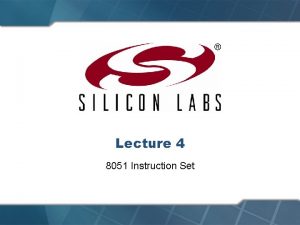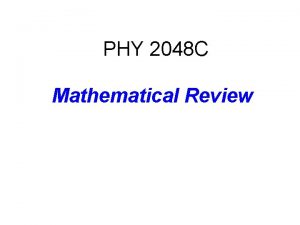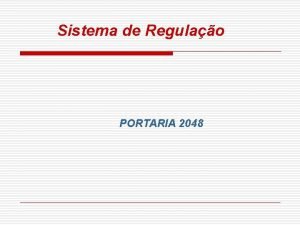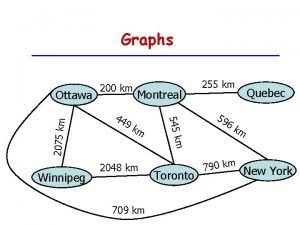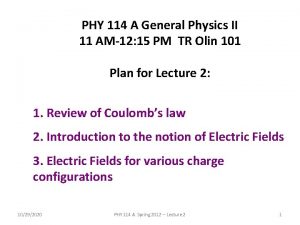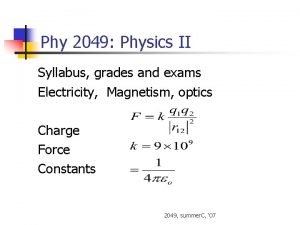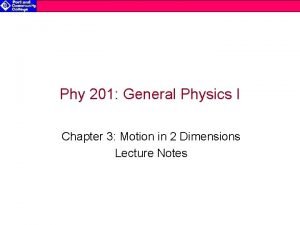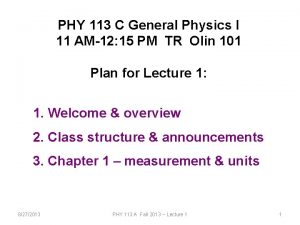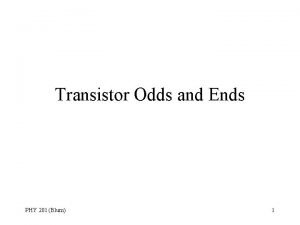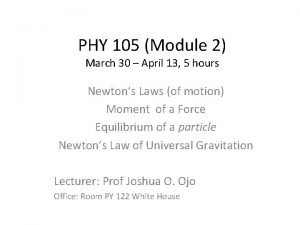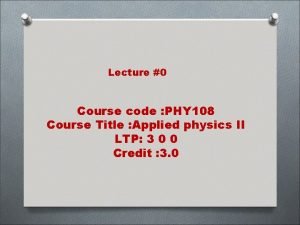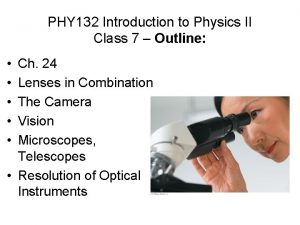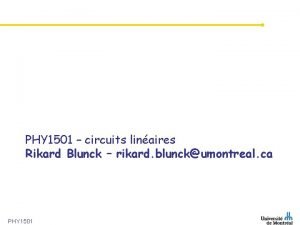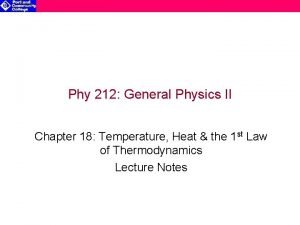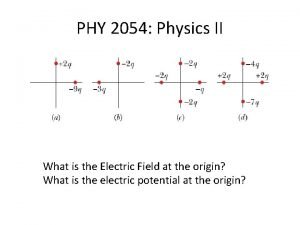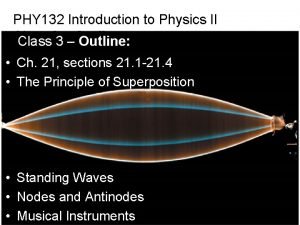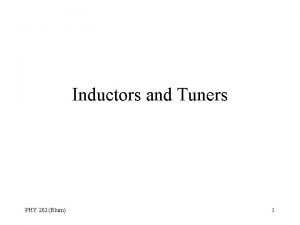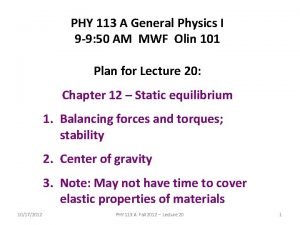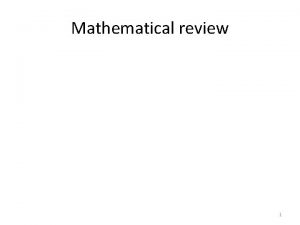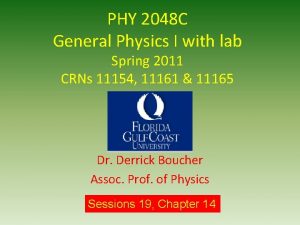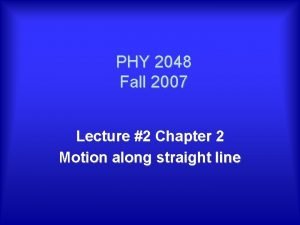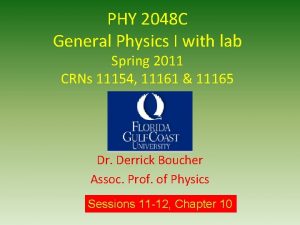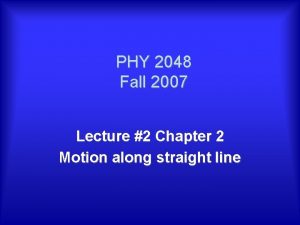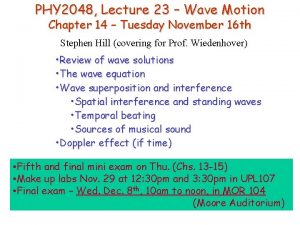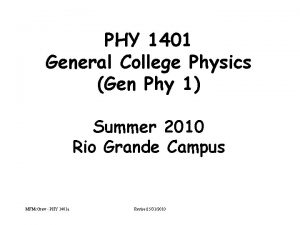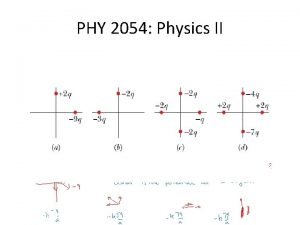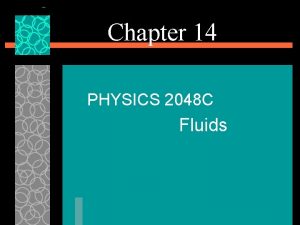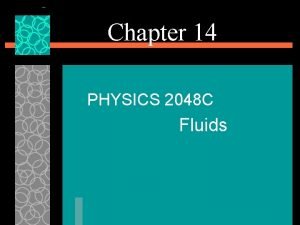PHY 2048 C Mathematical Review PHY 2048 C





















































- Slides: 53

PHY 2048 C Mathematical Review

PHY 2048 C Mathematical Review Note: The following mathematical concepts will be used extensively in this physics course. Meeting the prerequisites indicates that you have mastered the following material, however some of you may have not seen this material in a few semesters. If you are unsure of whether or not you have the appropriate mathematical background necessary to succeed in Physics with Calculus I, I encourage you take a look at the following review and to work out the practice examples on your own. Solutions are given on the following slide.

1. Algebra Quadratic Equations. If an equation can be put in the form: Ax 2+Bx+C = 0 Then the two solutions are given by the quadratic formula: Example: Solve for t: A = 4. 9, B = -8. 0, C = -3. 6

1. Algebra Your Turn: Solve for q. 2. 8 q = 7. 0 – 4. 5 q 2

1. Algebra Your Turn: Solve for q. 2. 8 q = 7. 0 – 4. 5 q 2 Solution: q = -1. 60, 0. 97

1. Algebra Solving a system of multiple equations. If the n independent equations containing the less than n unknown variables each represented in each equation, the system can be solved for all n unknowns. Example: Solve the system of equations for x and y: (1) (2) 2. 0 x - 1. 7 y = 4. 1 3. 1 x - 5. 0 = 13. 0 y Solution: x = 2. 16, y = 0. 13 Steps: 1. 2. 3. 4. Solve equation (2) for y: y = (3. 1 x – 5. 0)/13. 0 Plug this solution for y into equation (1) : 2. 0 x - 1. 7(3. 1 x – 5. 0)/13. 0 = 4. 1 Solve for x: x = 2. 16 Knowing x, solve for y: y = 0. 13

1. Algebra Your Turn: Solve the system of equations for x and y. (1) (2) 5. 0 x - 4. 0 y = 3. 1 6. 0 x – 7. 2 y + 8. 0 = 0

1. Algebra Your Turn: Solve the system of equations for x and y. (1) (2) 5. 0 x - 4. 0 y = 3. 1 6. 0 x – 7. 2 y + 8. 0 = 0 Solution: x = -0. 91, y = -0. 36

2. Trigonometry The trigonometric functions sine, cosine, and tangent are defined as the following ratios of sides of a right triangle:

2. Trigonometry Example: Determine the height of a building if, as you stand 67. 2 m from the building you can just see the Sun over the top of the building at an altitude angle of 50º. Solution:

2. Trigonometry The inverse trig functions produce the angle from the ratio of the sides of the right triangle.

2. Trigonometry The inverse trig functions produce the angle from the ratio of the sides of the right triangle. Note: 0<θ<π (when using sin-1 or cos-1) 0 < θ < π/2 (when using tan-1) Here θ is given in radians (rad). 1 rad = 1º × 2π/360º

2. Trigonometry Example: A fisherman determines that the depth of a lake is 2. 25 m when he is 14. 0 m from the shore. If the bottom of the lake has a constant slope, determine the angle the bottom of the lake makes with the water’s surface. Solution:

2. Trigonometry Your Turn: Solve for θ in the right triangle shown below. 6. 32 m 2. 00 m 6. 00 m

2. Trigonometry Your Turn: Solve for θ in the right triangle shown below. 6. 32 m 2. 00 m 6. 00 m Solution: (0. 321 rad)

2. Trigonometry Pythagorean theorem:

2. Trigonometry Example: Determine the length of the hypotenuse of the right triangle shown below, R. R 2. 00 m 6. 00 m

2. Trigonometry Physics Example: A displacement vector has a magnitude of 175 m and points at an angle of 50. 0 degrees relative to the x axis. Find the x and y components of this vector.

3. Differential Calculus The definition of the derivative. The slope of the tangent line to a curve. Δx Δt

3. Differential Calculus Basic Differentiation Rules. 1. Example: 2. Example:

3. Differential Calculus Basic Differentiation Rules. 3. Example: 4. Example:

3. Differential Calculus More Differentiation Rules. 5. Product Rule Example: Derivative of the first function Derivative of the second function

3. Differential Calculus More Differentiation Rules. 6. Quotient Rule Sometimes remembered as:

3. Differential Calculus More Differentiation Rules. 6. Quotient Rule (cont. ) Example: Derivative of the numerator Derivative of the denominator

3. Differential Calculus More Differentiation Rules. 7. The Chain Rule Note: h(x) is a composite function. Another Version:

3. Differential Calculus More Differentiation Rules. The Chain Rule leads to The General Power Rule: Example:

3. Differential Calculus Chain Rule Example. Your Turn: Differentiate with respect to x.

3. Differential Calculus Chain Rule Example. Your Turn: Differentiate Solution: with respect to x.

3. Differential Calculus Chain Rule Example: Substitute for u:

3. Integral Calculus Anti-Derivatives, integrals, and the fundamental theorem of calculus. An anti-derivative of a function f(x) is a new function F(x) such that Indefinite integral: Definite integral:

3. Integral Calculus Definite Integral as Area Under the Curve. Exact Area=

3. Integral Calculus Definite Integral with Variable Upper Limit. , More “proper” form with “dummy” variable: Improper Integrals.

3. Integral Calculus Example: Determine using the figure below.

3. Integral Calculus Example: Determine Solution: using the figure below.

3. Integral Calculus Common Integrals.

3. Integral Calculus Common Integrals (Cont. )

3. Integral Calculus Your Turn: Integrate with respect to x.

3. Integral Calculus Your Turn: Integrate Solution: with respect to x.

3. Integral Calculus Your Turn: Integrate with respect to x.

3. Integral Calculus Your Turn: Integrate Solution: with respect to x.

3. Integral Calculus Your Turn: Integrate with respect to x.

3. Integral Calculus Your Turn: Integrate Solution: with respect to x.

3. Integral Calculus Your Turn: Determine the definite integral:

3. Integral Calculus Your Turn: Determine the definite integral: Solution:

3. Integral Calculus Your Turn: Determine the definite integral:

3. Integral Calculus Your Turn: Determine the definite integral: Solution:

3. Integral Calculus Physics Example: Displacement, Velocity, and Acceleration.

3. Integral Calculus Physics Example: Displacement, Velocity, and Acceleration.

3. Integral Calculus Physics Example: Displacement, Velocity, and Acceleration.

3. Integral Calculus Example: An object experiences acceleration as given by: where Determine the velocity and displacement.

3. Integral Calculus Example: An object experiences acceleration as given by: where Determine the velocity and displacement. Solution:

3. Integral Calculus Example: An object experiences acceleration as given by: where Determine the velocity and displacement. Solution (cont. ):

You’ve completed the PHY 2048 C mathematical review. Thanks! Note: On the first day of class, you will be given a quiz based on these concepts. Good luck!
 Mathematical vs non mathematical economics
Mathematical vs non mathematical economics Swap instruction in 8051 example
Swap instruction in 8051 example Jangmultimedia
Jangmultimedia 2048.c
2048.c Portaria 2048
Portaria 2048 Let me go mr hill chapter 2048
Let me go mr hill chapter 2048 Portaria 2048/09
Portaria 2048/09 10ud 2048
10ud 2048 Physics 2048
Physics 2048 2048 x 3
2048 x 3 Vhf sailor rt 2048
Vhf sailor rt 2048 2048 expectimax
2048 expectimax 2048 x 1556 aspect ratio
2048 x 1556 aspect ratio Phy
Phy Phy 2049
Phy 2049 Eyephy
Eyephy Phy theorem
Phy theorem Vx=vox+axt
Vx=vox+axt Phy 1214
Phy 1214 Pa msu
Pa msu Life phy
Life phy Phy
Phy Phy 131 asu
Phy 131 asu Phy-105 5 discussion
Phy-105 5 discussion Phy 110
Phy 110 Phy 2049
Phy 2049 Phy 221 msu
Phy 221 msu Phy 108
Phy 108 Phy 132 lecture 10: ch30
Phy 132 lecture 10: ch30 Rikard blunck
Rikard blunck Atm basics
Atm basics General physics
General physics Ddr phy architecture
Ddr phy architecture Physics heat and temperature
Physics heat and temperature Complete motion diagram
Complete motion diagram Physics 2
Physics 2 Phy theorem
Phy theorem Phy tgen
Phy tgen Phy 1214
Phy 1214 Phy
Phy Phy 1214
Phy 1214 Phy 205
Phy 205 General physics chapters
General physics chapters Phy 132
Phy 132 Phy 131 past papers
Phy 131 past papers Phy
Phy Phy
Phy Phy113
Phy113 2012 phy
2012 phy Narrative review vs systematic review
Narrative review vs systematic review Ap gov review final exam review
Ap gov review final exam review Narrative review vs systematic review
Narrative review vs systematic review What is inclusion and exclusion criteria
What is inclusion and exclusion criteria Chapter review motion part a vocabulary review answer key
Chapter review motion part a vocabulary review answer key

